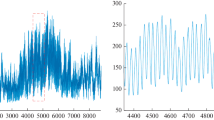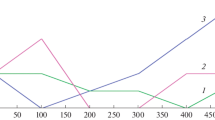Abstract
In this article, we aim to improve the prediction from experts’ aggregation by using the underlying properties of the models that provide the experts involved in the aggregation procedure. We restrict ourselves to the case where experts perform their predictions by fitting state-space models to the data using Kalman recursions. Using exponential weights, we construct different Kalman recursions Aggregated Online (KAO) algorithms that compete with the best expert or the best convex combination of experts in a more or less adaptive way. When the experts are Kalman recursions, we improve the existing results on experts’ aggregation literature, taking advantage of the second-order properties of the Kalman recursions. We apply our approach to Kalman recursions and extend it to the general adversarial expert setting by state-space modeling the experts’ errors. We apply these new algorithms to a real-data set of electricity consumption and show how they can improve forecast performances compared to other exponentially weighted average procedures.






Similar content being viewed by others
References
Amat C, Michalski T, Stoltz G (2018) Fundamentals and exchange rate forecastability with simple machine learning methods. J Int Money Financ 88:1–24
Audibert JY (2007) No fast exponential deviation inequalities for the progressive mixture rule. Adv Neural Inf Process Syst 2041–2048
Auger F, Hilairet M, Guerrero JM et al (2013) Industrial applications of the Kalman filter: a review. IEEE Trans Ind Electron 60(12):5458–5471
Ba A, Sinn M, Goude Y et al (2012) Adaptive learning of smoothing functions: application to electricity load forecasting. Neurips, pp 2519–2527. http://books.nips.cc/papers/files/nips25/NIPS2012_1205.pdf
Carlson NA, Berarducci MP (1994) Federated Kalman filter simulation results. Navig J Inst Navig 41(3):297–322
Carrassi A, Bocquet M, Bertino L et al (2018) Data assimilation in the geosciences: an overview of methods, issues, and perspectives. WIREs Clim Change 9(5):e535. https://doi.org/10.1002/wcc.535
Cassola F, Burlando M (2012) Wind speed and wind energy forecast through Kalman filtering of numerical weather prediction model output. Appl Energy 99:154–166. https://doi.org/10.1016/j.apenergy.2012.03.054
Cesa-Bianchi N, Lugosi G (2006) Prediction, learning, and games, vol 2. Cambridge University Press, London. https://doi.org/10.1017/cbo9780511546921
Cesa-Bianchi N, Mansour Y, Stoltz G (2007) Improved second-order bounds for prediction with expert advice. Mach Learn 66(2–3):321–352
Chen S (2011) Kalman filter for robot vision: a survey. IEEE Trans Ind Electron 59(11):4409–4420
Clark S, Hyndman RJ, Pagendam D et al (2020) Modern strategies for time series regression. Int Stat Rev 88(S1):S179–S204
De Franco C, Geissler C, Margot V et al (2020) ESG investments: filtering versus machine learning approaches. arXiv preprint. arXiv:2002.07477
De Vilmarest J, Goude Y (2022) State-space models for online post-covid electricity load forecasting competition. IEEE Open Access J Power Energy. https://doi.org/10.1109/OAJPE.2022.3141883
de Vilmarest J, Wintenberger O (2021) Stochastic online optimization using Kalman recursion. JMLR 22:1–55
Devaine M, Gaillard P, Goude Y et al (2013) Forecasting electricity consumption by aggregating specialized experts. Mach Learn 90(2):231–260
Diderrich GT (1985) The Kalman filter from the perspective of Goldberger—Theil estimators. Am Stat 39(3):193–198
Dordonnat V, Koopman SJ, Ooms M (2012) Dynamic factors in periodic time-varying regressions with an application to hourly electricity load modelling. Comput Stat Data Anal 56(11):3134–3152
Durbin J, Koopman SJ (2012) Time series analysis by state space methods. Oxford University Press, London. https://doi.org/10.1093/acprof:oso/9780199641178.001.0001
Evensen G (2002) Sequential data assimilation for nonlinear dynamics: the ensemble Kalman filter. Springer, Cham, pp 97–116. https://doi.org/10.1007/978-3-662-22648-3_6
Freund Y, Schapire RE (1997) A decision-theoretic generalization of on-line learning and an application to boosting. J Comput Syst Sci 55(1):119–139
Gaillard P, Goude Y (2014) Forecasting electricity consumption by aggregating experts; how to design a good set of experts. Lecture notes in statistics: modeling and stochastic learning for forecasting in high dimension
Gaillard P, Goude Y (2016) Opera: online prediction by expert aggregation, r package version 1.0. https://CRAN.R-project.org/package=opera
Gaillard P, Wintenberger O (2017) Sparse accelerated exponential weights. In: Artificial intelligence and statistics, PMLR, pp 75–82
Gaillard P, Wintenberger O (2018) Efficient online algorithms for fast-rate regret bounds under sparsity. In: Advances in neural information processing systems, pp 7026–7036
Gaillard P, Stoltz G, Van Erven T (2014) A second-order bound with excess losses. In: Conference on learning theory, pp 176–196
Gaillard P, Goude Y, Nedellec R (2016) Additive models and robust aggregation for GEFCom2014 probabilistic electric load and electricity price forecasting. Int J Forecast 32(3):1038–1050
Geysen D, De Somer O, Johansson C et al (2018) Operational thermal load forecasting in district heating networks using machine learning and expert advice. Energy Build 162:144–153
Giraud C (2008) Mixing least-squares estimators when the variance is unknown. Bernoulli 14(4):1089–1107
Goehry B, Goude Y, Massart P et al (2019) Aggregation of multi-scale experts for bottom-up load forecasting. IEEE Trans Smart Grid 11(3):1895–1904
Govaers F, Koch W (2012) An exact solution to track-to-track-fusion at arbitrary communication rates. IEEE Trans Aerosp Electron Syst 48(3):2718–2729
Guo L (1994) Stability of recursive stochastic tracking algorithms. SIAM J Control Optim 32(5):1195–1225
Hand DJ (2008) Forecasting with exponential smoothing: the state space approach by Rob J. Hyndman, Anne B. Koehler, J. Keith Ord, Ralph D. Snyder. Int Stat Rev 77(2):315–316. https://doi.org/10.1111/j.1751-5823.2009.00085_17.x
Hazan E (2016) Introduction to online convex optimization. Found Trends® Optim 2(3–4):157–325
Herbster M, Warmuth MK (1998) Tracking the best expert. Mach Learn 32(2):151–178
Huard M, Garnier R, Stoltz G (2020) Hierarchical robust aggregation of sales forecasts at aggregated levels in e-commerce, based on exponential smoothing and Holt’s linear trend method. Working paper or preprint. https://hal.archives-ouvertes.fr/hal-02794320
Kalman RE (1960) A new approach to linear filtering and prediction problems. J Basic Eng 82(1):35–45. https://doi.org/10.1115/1.3662552
Littlestone N, Warmuth MK (1994) The weighted majority algorithm. Inf Comput 108(2):212–261
Mackenzie D (2003) Ensemble Kalman filters bring weather models up to date. SIAM News 36(8):10–03
McGee LA, Schmidt SF (1985) Discovery of the Kalman filter as a practical tool for aerospace and industry. Vol. 86847. National Aeronautics and Space Administration
R Core Team (2019) R: a language and environment for statistical computing. R Foundation for Statistical Computing, Vienna. https://www.R-project.org/
Ridder KD, Kumar U, Lauwaet D et al (2012) Kalman filter-based air quality forecast adjustment. Atmos Environ 50:381–384. https://doi.org/10.1016/j.atmosenv.2012.01.032
Rigby RA, Stasinopoulos DM (2005) Generalized additive models for location, scale and shape. J R Stat Soc Ser C (Appl Stat) 54(3):507–554
Schneider W (1988) Analytical uses of Kalman filtering in econometrics—a survey. Stat Pap 29(1):3–33
Thorey J, Chaussin C, Mallet V (2018) Ensemble forecast of photovoltaic power with online CRPS learning. Int J Forecast 34(4):762–773
Tsay RS (2005) Analysis of financial time series, 2nd edn. Wiley, Hoboken
Vovk VG (1990) Aggregating strategies. In: Proceedings of computational learning theory
Vovk V (1998) A game of prediction with expert advice. J Comput Syst Sci 56(2):153–173
Wintenberger O (2017) Optimal learning with Bernstein online aggregation. Mach Learn 106(1):119–141
Wood S (2015) Package ‘mgcv’. R package version 1(29):729
Acknowledgements
We would like to thank Joseph de Vilmarest for fruitful discussions and the share of codes.
Author information
Authors and Affiliations
Corresponding author
Additional information
Publisher's Note
Springer Nature remains neutral with regard to jurisdictional claims in published maps and institutional affiliations.
Supplementary Information
Below is the link to the electronic supplementary material.
Rights and permissions
Springer Nature or its licensor (e.g. a society or other partner) holds exclusive rights to this article under a publishing agreement with the author(s) or other rightsholder(s); author self-archiving of the accepted manuscript version of this article is solely governed by the terms of such publishing agreement and applicable law.
About this article
Cite this article
Adjakossa, E., Goude, Y. & Wintenberger, O. Kalman recursions Aggregated Online. Stat Papers 65, 909–944 (2024). https://doi.org/10.1007/s00362-023-01410-7
Received:
Revised:
Published:
Issue Date:
DOI: https://doi.org/10.1007/s00362-023-01410-7




